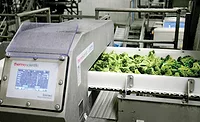How multi-simultaneous frequency technology in metal detectors reduces false rejects

Metal detection systems are designed to identify foreign ferrous, non-ferrous and stainless-steel contaminants in food products and reject those products before harming consumers. These systems are sometimes challenged by what is known as “product effect,” which is produced by certain product properties (e.g., high salt, moisture or iron content and temperature variation) that can produce signals causing the metal detector to falsely reject uncontaminated products.
A new technology dramatically reduces product effect and minimizes false rejects, thus reducing the risk that clean product will be rejected and wasted, and preventing contaminated products from reaching the market.
Metal detection technology
A metal detector is a simple yet effective and reliable device. It consists of a set of three electric coils that are “balanced.” These wound copper wire coils create an aperture through which products pass to be inspected—a center coil (the transmitter coil) and two outer coils (the receiver coils). A high-frequency input to the transmitter coil generates an electromagnetic field within the aperture that in turn induces a small voltage in each of the receiver coils, which have reversed polarities.
The metal detector continuously measures the difference between these two voltages, which should be zero when there is no product being inspected. When a food product containing a metal contaminant passes through the aperture, it disrupts the balance of the voltages and the metal detector identifies the product for rejection.
Product effect
Product effect complicates this simple process. High salt, moisture and iron content in the product itself or changing product temperature increases a product’s conductivity. This can also disrupt the voltage balance between the receiver coils, leading the metal detector to incorrectly identify the product as contaminated and reject it.
The characteristics that create product effect are fairly common in frozen products that begin to thaw slightly as they travel along the production line. Product effect can also be caused by thermal changes in products, which can be especially problematic when circumstances slow line speed. A change of as little as 5°C can create a product effect.
Looking for quick answers on food safety topics?
Try Ask FSM, our new smart AI search tool.
Ask FSM →
Mixed products––packaged dinners of meat, potatoes and vegetables, for example––present a different conductivity than a single piece of boneless beef, which is in turn different from a bone-in piece of beef. Product effect can also be affected by certain packaging when packaged products are inspected, for example, if the packaging includes metallized film.
Clearly, there are many factors that affect the characteristics of a product, and they are difficult to control on a production line that is primarily focused on maintaining throughput. To compensate for these factors, companies sometimes try to decrease the sensitivity level of a metal detector to eliminate false rejects. Doing so can also allow contaminants to go undetected.
Multi-simultaneous frequency metal detectors
Traditional metal detector technology has always involved a tradeoff between product effect, maximum operating frequency and detector sensitivity. The higher the potential for product effect (in a moist, salty, temperature-variable product), the lower the optimal operating frequency, thus lowering the sensitivity of the detector. Conversely, the lower the potential for product effect (in a dry, stable product), the higher the operating frequency can be, successfully detecting the smallest metal contaminants.
Today, the newest, most sensitive metal detectors are known as multi-simultaneous frequency (MSF) detectors. They operate at more than one frequency simultaneously, which enables them to meet the challenge of product effect in an innovative way.
Some sophisticated new systems use built-in product signal suppression (PSS) technology that incorporates two stages of discrimination, canceling the input information from the combined low and high frequencies to effectively remove the product effect signal, allowing them to detect even smaller metal contaminants.
This new technology also enables the metal detector to deal effectively with product variations. In actual practice, the metal detector is “taught” the characteristics of the product it is to inspect. In less sophisticated systems, even slight variations in individual product characteristics, such as moisture content or temperature, can result in false rejects. PSS technology enables the system to adjust for these variations in each product and consistently detect small contaminants. This technology can even compensate for the variation caused by several products simultaneously passing through the metal detector, as can occasionally happen on a busy production line.
The benefit of this new technology is a significant improvement in metal detection effectiveness in multi-simultaneous frequency detectors over single-frequency detectors of as much as 50%, even in metallized film applications.
In challenging metal detection applications, where products are highly conductive or are changing temperature as they are inspected, overcoming product effect has long been difficult to achieve. Efforts to improve detection of contaminants have increased as consumers have become more concerned about contamination. Increasing metal detector sensitivity to provide better detection has proven to actually increase false rejects of good product. The resulting waste can be extremely costly for manufacturers. Conversely, attempting to control this loss by reducing detector sensitivity allows more products to “pass,” but also increases the risk of products containing metal contaminants reaching the marketplace.
The development of multiple-simultaneous frequency and PSS technology now addresses this dilemma, significantly reducing–or even entirely eliminating–costly false reject rates while detecting metal contaminants in products.
This article was originally posted on www.refrigeratedfrozenfood.com.








